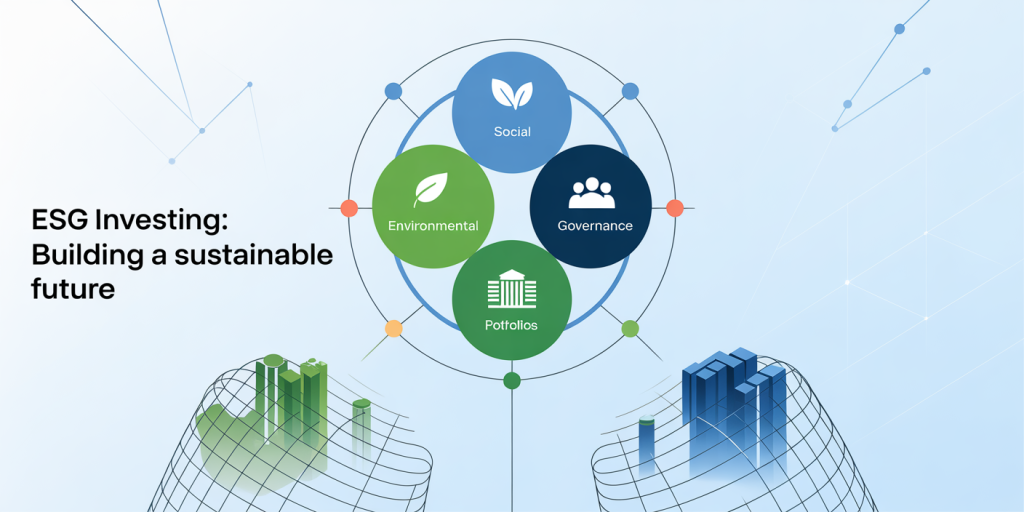Understanding ESG Investing: Does It Really Make a Difference?
Environmental, Social, and Governance (ESG) investing has gained significant momentum in recent years, transforming the way investors evaluate companies beyond traditional financial metrics. As awareness of sustainability and social responsibility climbs, ESG investing promises to optimize portfolios by integrating ethical values with profitability. Yet, questions remain: Does ESG investing genuinely influence corporate behavior? Does it deliver better financial results? This article explores these issues with in-depth analysis, real-world examples, and data-driven insights to help investors, analysts, and stakeholders understand the true impact of ESG investing.
The Rise of ESG Investing: Context and Background
ESG investing originated from socially responsible investing (SRI), which excluded investments in harmful industries like tobacco and firearms. However, ESG has a broader scope, encompassing environmental sustainability, corporate social responsibility, and governance quality as integral elements in investment decisions. According to the Global Sustainable Investment Alliance (GSIA), global sustainable investment assets reached $35.3 trillion in 2020, representing 36% of all professionally managed assets — a clear indicator of rising interest.
Environmental criteria look at how companies mitigate climate change risks, resource use, waste management, and pollution. Social criteria evaluate relationships with employees, suppliers, customers, and communities. Governance focuses on leadership, executive pay, audits, internal controls, and shareholder rights. Together, these factors provide a more holistic view of risks and opportunities. Investors use ESG ratings and scores provided by agencies like MSCI, Sustainalytics, and Bloomberg to compare companies, influencing capital allocation.

Financial Performance: Myth or Reality?
One of the most frequently debated questions is whether ESG investing compromises or enhances financial returns. Early critics claimed that ESG considerations impose constraints that limit diversification and reduce returns. However, a growing body of research challenges this notion, suggesting ESG can be financially beneficial.
A meta-analysis by Friede, Busch, and Bassen (2015) reviewed over 2,200 empirical studies and found that approximately 90% reported a non-negative correlation between ESG factors and corporate financial performance (CFP). Companies with strong ESG performance tend to have lower cost of capital, reduce regulatory and litigation risks, and enhance operational efficiencies.

For example, Unilever, a global consumer goods company, is often cited as an ESG success story. Since implementing their Sustainable Living Plan, Unilever’s ESG scores have risen consistently, accompanied by above-market revenue growth. Their “brand purpose” strategy targets sustainability-conscious consumers, giving them a competitive edge.
| Company | ESG Score (2023)* | Annual Revenue Growth (2018-2023) | Stock Performance (5 Years) |
|---|---|---|---|
| Unilever | 76 / 100 | 5.2% | +45% |
| Procter & Gamble | 68 / 100 | 3.8% | +30% |
| ExxonMobil | 45 / 100 | 2.1% | +15% |
*ESG scores from MSCI
Conversely, ExxonMobil’s lower ESG score corresponds with regulatory scrutiny and growing controversies over fossil fuel reliance. Although financial performance depends on various factors, ESG provides a meaningful lens to anticipate risks and adapt strategies.
Real-World Impact on Corporate Behavior
Beyond investment returns, does ESG investing compel companies to improve their practices? Evidence suggests ESG funds exert pressure by directing capital toward responsible companies while penalizing poor performers.
Governments and regulatory bodies bolster this effect. For instance, the European Union’s Sustainable Finance Disclosure Regulation (SFDR) requires fund managers to disclose how ESG factors are integrated. This transparency motivates companies to enhance ESG practices to maintain investor interest.
A practical case is the response of energy firms to climate change concerns. Facing divestment threats and shareholder activism, BP and Shell committed to Net Zero carbon emissions by 2050. These goals influence operational decisions such as increasing renewable energy investments and phasing out coal assets. ESG-driven activism contributed to this shift, illustrating that ESG investing can be a catalyst for transformation.
However, challenges remain. “Greenwashing,” where companies exaggerate ESG claims without substantial action, undermines trust. Some firms may achieve high ESG scores through selective disclosures. Investors and regulators call for standardized reporting frameworks like the Task Force on Climate-related Financial Disclosures (TCFD) and the newly established International Sustainability Standards Board (ISSB) to enhance accuracy.
Sectoral Differences and ESG Integration Strategies
The impact and methodology of ESG investing vary by industry sector and investment approach. For example, technology companies face distinct ESG challenges, focusing heavily on data privacy, labor practices, and energy usage in data centers. Meanwhile, manufacturing faces environmental pollution and supply chain labor issues.
Investors use different integration strategies to implement ESG: Negative Screening: Excluding companies that do not meet ESG criteria (e.g., tobacco, firearms). Positive Screening: Selecting companies with superior ESG performance. Thematic Investing: Focusing on a sustainability-related theme, like renewable energy or gender diversity. Impact Investing: Directing capital to projects with measurable environmental or social outcomes. ESG Integration: Incorporating ESG factors alongside traditional financial analysis comprehensively.
A comparative overview of ESG strategies:
| Strategy | Description | Benefits | Drawbacks |
|---|---|---|---|
| Negative Screening | Excludes companies with poor ESG standards | Simple, aligns with values | May limit diversification |
| Positive Screening | Chooses best ESG performers within a sector | Encourages improvement | High ESG scores may mask risks |
| Thematic Investing | Targets specific ESG themes | Directs capital to priority areas | May lack diversification |
| Impact Investing | Focuses on measurable social/environmental outcomes | Aligns profits with impact goals | Often lower liquidity |
| ESG Integration | Combines ESG with financial metrics | Comprehensive risk assessment | Complex, data-intensive |
Institutional investors typically favor ESG integration due to its balanced approach. For example, BlackRock, the world’s largest asset manager, integrates ESG analysis into nearly all its portfolios, emphasizing its role in risk management.
Challenges and Criticisms of ESG Investing
While ESG investing has undeniable benefits, it is not without criticism and operational challenges. One major issue is the lack of standardized ESG metrics, leading to inconsistent ratings and “rating shopping” by companies. For instance, a firm may be rated highly by one agency and poorly by another because of differing methodologies.
Furthermore, some critics argue that ESG investing may prioritize ethics over economic realities, potentially exposing investors to unexpected risks. During the COVID-19 pandemic, some ESG funds experienced volatility similar to traditional funds, questioning whether ESG criteria alone can protect against systemic crises.
Another concern is greenwashing, where companies or funds overstate ESG commitments. A report by the U.S. Government Accountability Office in 2022 found misleading sustainability claims in various asset management products, highlighting the need for regulatory oversight.
Social and governance components also involve subjective assessments. For example, defining “good labor practices” can vary by country and culture, complicating evaluation.
Lastly, ESG investing can sometimes promote “moral hazard,” where companies rely on positive PR without substantive change. Thus, continuous engagement and rigorous analysis remain essential.
Future Perspectives: ESG Investing in the Next Decade
Looking ahead, ESG investing is poised to evolve significantly, driven by regulatory developments, technological advancements, and shifting investor expectations.
Regulatory frameworks worldwide are tightening. The EU’s Corporate Sustainability Reporting Directive (CSRD), effective from 2024, mandates more comprehensive ESG disclosures from publicly traded companies. Meanwhile, the U.S. Securities and Exchange Commission (SEC) has proposed climate risk disclosure rules for listed firms. These mandates will enhance transparency and comparability, reducing greenwashing.
Technological innovations like artificial intelligence and blockchain promise to improve ESG data collection, verification, and impact tracking. For example, AI-driven ESG analytics platforms can process vast datasets, including satellite imagery, social media sentiment, and supply chain information to generate real-time insights.

Investor preferences will continue shifting toward impact and thematic investments. According to Morningstar, ESG funds attracted record inflows of $51 billion in 2023 alone, indicating robust demand. Younger generations, particularly Millennials and Gen Z, prioritize sustainability, suggesting long-term growth.
ESG integration will increasingly move beyond screening. The focus will shift toward active ownership, where investors engage directly with companies to drive improvements, demanding accountability and transparency.
Finally, climate change remains a critical driver. Aligning capital flows with the Paris Agreement goals is imperative, accelerating the transition to a low-carbon economy. ESG investing will be central to mobilizing finance for renewable energy, clean technologies, and sustainable infrastructure.
In summary, ESG investing has evolved from a niche approach to a mainstream investment philosophy influencing corporate strategies and capital markets. While challenges such as data inconsistencies, greenwashing, and subjective assessments persist, ESG investing undeniably helps identify long-term risks and opportunities. Real-world evidence shows that companies embracing ESG principles often achieve competitive financial performance and create meaningful environmental and social impact. As regulatory frameworks and technologies mature, ESG investing will likely become more standardized, effective, and integral to global financial systems. Investors who understand its nuances and apply ESG thoughtfully can make a tangible difference—financially and societally.
